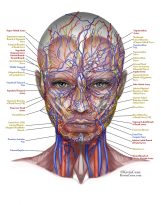
Bruising…it may be the single greatest fear in all of us who chose to undergo anti-aging treatments like Botox and Dermal Fillers. We’ve undergone the treatment to look our best and then walk around sporting an unsightly mark declaring to all that we’ve succumbed to our vanity. 😊
As you can see from the photo, it’s amazing that we don’t bruise far more often! While we never promise that a client won’t get a bruise from injectable or other treatments, we can share steps to reduce the risk by quite a bit.
A Week Before Your Procedure
To reduce bruising risk, avoid those things we know increase bleeding:
- NSAIDS (aspirin, Motrin, Aleve, etc.)
- Vitamin E
- Alcohol
- Omega 3 Oils
- Green Tea
- Garlic
- Gingko
Avoiding the above for a week to ten days prior to your treatment and two to three days after will help reduce the amount of bruising you may suffer as they can cause an awful lot of bruising from a simple injection. Taking it easy the day of and for two days after will also help. The more your heart rate goes up, the higher the risk for swelling and bruising. Activities that require your head to be below your heart should also be avoided during this time.
Ice, Ice, Baby
Topical anesthetics aren’t very effective for injections…once the needle pierces the skin, they have no benefit, can actually cause swelling of the tissue and in some cases, cause an unpleasant allergic reaction.
We are fans of applying ice to the skin prior to each puncture – this will not only anesthetize the skin a bit but will help vasoconstrict to reduce bruising risks. Ice will be sent home with you so that you can continue application after treatment…especially in the summer when your car is SO hot!
Of course, ensuring injections take place in a well-lit room (with natural light, when possible), helps us see blood vessels in areas where skin is thinner, like around the eyes and mouth.
Choosing the best entry point to avoid vessels is one method to reduce bruising, but in areas that are highly vascular and skin is thinner, use of a blunt tip cannula may assist in reducing the risk of bruising. In no way, however, should cannulas be counted on to guarantee it won't happen. We make a wheal of lidocaine with epinephrine at the injection site to provide hemostasis and allow progress of the cannula to lower the potential for a bruise. If we see any bleeding when the needle or cannula is removed, we immediately apply pressure and may even ask you to help so that we can move on to the next site. Ideally, five minutes or so of firm pressure can greatly reduce the expansion and size of any bruise.
In Spite Of All Our Precautions…
We have a number of options to treat bruises that do occur.
- Cearna OcuMend Pads are infused with high dose medical Arnica and can be applied immediately post treatment. Not only are they soothing to the skin, studies show they provide a higher dose of Arnica directly into the skin than do any pills or topicals available as well as an impressive reduction in bruising. Some clients opt not to use them…they are an additional, but low cost, add on to treatment or they are heading to lunch or back to work where they can’t have anything on their face.
- The pads are most effective when worn for six hours immediately post treatment, and then again at bedtime.
- Siligen, an oral capsule released by the same company that provides silicone scar gel, contains Arnica Montana, Bromelain, Vit C, and Zinc to reduce the duration of any bruise that may occur.
- Sin-Ecch – a surgical strength Arnica Montana capsule.
- Auriderm – a topical cream infused with Vitamin K oxide to treat bruising. It smells much better than any topical Arnica that we’ve found.
At Home Remedies:
- Dabbing the bruise several times a day with a cotton ball dipped in Apple Cider Vinegar (do not leave on as a mask as it may then cause irritation to the skin)
- Mixing cayenne pepper with Vaseline and cooling the mixture in the refrigerator before applying it to the bruise.
- Increasing oral intake of Vitamin C and eating foods rich in Vitamin K (spinach, parsley, broccoli, brussel sprouts and romaine lettuce) may also help.
- After 48 hours, warm compresses applied to the bruise will help vasodilate, allowing increased blood flow to clear the tissue.
- A few days after treatment, you may opt to return to the office to have the bruise treated with photo (light) based therapy. The light targets the pigment to resolve the bruise faster.
Lastly, planning your injections is key! A minimum of two weeks between treatment and any special event is so important. Just like that guy Murphy said “If you CAN’T be bruised, you WILL bruise.”

